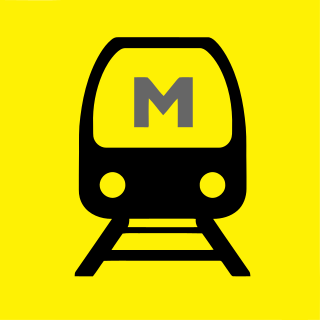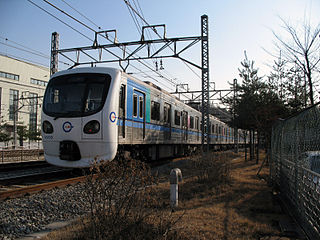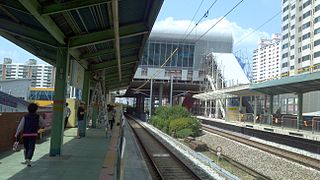
Véhicule Automatique Léger or VAL is a type of driverless (automated), rubber-tyred, medium-capacity rail transport system. The technology was developed at the Lille University of Science and Technology, was marketed by Matra, and first used in the early 1980s for the Lille Metro system, one of the world's first fully automated mass-transit rail networks, preceded only by the Port Island Line in Kobe, Japan. The VAL technology is now marketed by Siemens, which acquired Matra in the late 1990s.

The Seoul Metropolitan Subway is a metropolitan railway system consisting of 23 rapid transit, light metro, commuter rail and people mover lines located in northwest South Korea. The system serves most of the Seoul Metropolitan Area including the Incheon metropolis and satellite cities in Gyeonggi province. Some regional lines in the network stretch out beyond the Seoul Metropolitan Area to rural areas in northern Chungnam province and western Gangwon Province, that lie over 100 km (62 mi) away from the capital.

Rapid transit systems operate in six major South Korean cities, except for Sejong.

Uijeongbu is a city in Gyeonggi Province, South Korea.

Seoul Subway Line 1 of the Seoul Metropolitan Subway is a rapid transit and commuter rail line which links central Seoul, South Korea to Yeoncheon in the northeast, Incheon in the southwest, and Sinchang via Suwon and Cheonan in the south. The central underground portion of Line 1, running underneath Sejongno, Jongno, and Wangsan-ro avenues along Seoul's traditional downtown area, is the oldest subway-operated section in the Seoul Metropolitan Subway system. Its branches and services cover a large part of the Seoul Capital Area; totaling 218.3 km (135.6 mi) in route length.

Seoul Subway Line 2, also known as the Circle Line, is a circular line of the Seoul Metropolitan Subway. The line running clockwise is called the "inner circle line" and the counter-clockwise line is called the "outer circle line". This is Seoul's most heavily used line, and consists of the main loop, the Seongsu Branch and the Sinjeong Branch for a total line length of 60.2 km (37.4 mi). The Line 2 loop is the third longest subway loop in the world after Moscow Metro Bolshaya Koltsevaya line and Beijing Subway Line 10. In 2019, Line 2 had an annual ridership of 812 million passengers or 2.2 million passengers per day.

Seoul Subway Line 7 of the Seoul Metropolitan Subway was built from 1990 to 1996 and was completed on August 1, 2000 ; the western section between Sinpung and Onsu was put into service on February 29, 2000. This north-south line does not run through the city centre but links Gangnam directly to the northeastern districts of Seoul. In 2019, Line 7 had an annual ridership of 380 million or 1.04 million passengers per day. Although most trains run between Jangam and Seongnam, some trains short turn at Onsu station and some trains start at Dobongsan station.

The Incheon Subway is a subway system serving the South Korean city of Incheon. The system is operated by Incheon Transit Corporation, and is part of the greater Seoul Metropolitan Subway.

Seoul Metropolitan Rapid Transit Corporation (SMRT) was established in 1994 to operate the Seoul Subway lines 5, 6, 7, 8 in Seoul, South Korea.

Incheon Subway Line 1 is a 30.3-kilometer (18.8 mi) north-south subway line, part of the Incheon Subway system. The line is also included as a part of the overall Seoul Metropolitan Subway network; Bupyeong Station has a free transfer with Seoul Subway Line 1, Gyeyang Station connects with the AREX Line which leads to Incheon International Airport and Seoul Station, Bupyeong-gu Office Station has a free transfer with Seoul Subway Line 7, and Woninjae Station has a free transfer with the Suin-Bundang Line.

Yongin EverLine is a fully automated driverless 18.1-kilometer (11.2 mi) people mover line in Yongin, Gyeonggi Province, Seoul Capital Area connecting Everland, South Korea's most popular theme park, to the Suin-Bundang Line of the Seoul Metropolitan Subway, a system which it is arguably a part of. The system is identical to the AirTrain JFK people mover and airport rail link in New York City, using single-car Bombardier Advanced Rapid Transit vehicles controlled by Bombardier CITYFLO 650 automatic train control technology.
City Hall Station or City Hall station may refer to:

A medium-capacity system (MCS), also known as light rapid transit or light metro, is a rail transport system with a capacity greater than light rail, but less than typical heavy-rail rapid transit. MCS trains are usually 1 to 4 cars. Most medium-capacity rail systems are automated or use light-rail type vehicles.
Seoul, the capital and largest city in South Korea, accounts for only 0.6% of the country's total land area, yet it is home to around 19% of the population. The population density in Seoul demands a great deal of the city's transportation systems, which are regarded by many as among the best and most advanced in the world. Seoul is very well connected by its subway and bus systems, and the city is also very supportive of pedestrian foot travel. In 2006 it won the Sustainable Transport Award.

Hoeryong Station is a metro station on Seoul Subway Line 1. In July 2012 it became a transfer station to the U Line. It lies in the city of Uijeongbu.

Incheon Subway Line 2 is a driverless, medium-capacity subway line running 29.2 km (18.1 mi) from Oryu-dong in Seo-gu to Incheon Grand Park, with 27 stations, part of the Incheon Subway system. The line is also included as a part of the overall Seoul Metropolitan Subway network; Juan station has a free transfer with Seoul Subway Line 1, Geomam station connects with the AREX Line to Incheon International Airport and Seoul Station, and Seongnam also has a free transfer with Seoul Subway Line 7.

Rapid transit or mass rapid transit (MRT), commonly referred to as metro, is a type of high-capacity public transport that is generally built in urban areas. A grade separated rapid transit line below ground surface through a tunnel can be regionally called a subway, tube, or underground. They are sometimes grade-separated on elevated railways, in which case some are referred to as el trains – short for "elevated" – or skytrains. Rapid transit systems are railways, usually electric, that unlike buses or trams operate on an exclusive right-of-way, which cannot be accessed by pedestrians or other vehicles.

Tapseok Station is a station of the U Line in Yonghyeon-dong, Uijeongbu, Gyeonggi-do, South Korea. Line 7 on the Seoul Subway is planned to be extended towards Pocheon, via this station.

Seoul Transportation Corporation, branded as Seoul Metro, is a municipal-owned corporation owned by Seoul Metropolitan Government, and one of the two major operators of Seoul Metropolitan Subway with Korail.

















